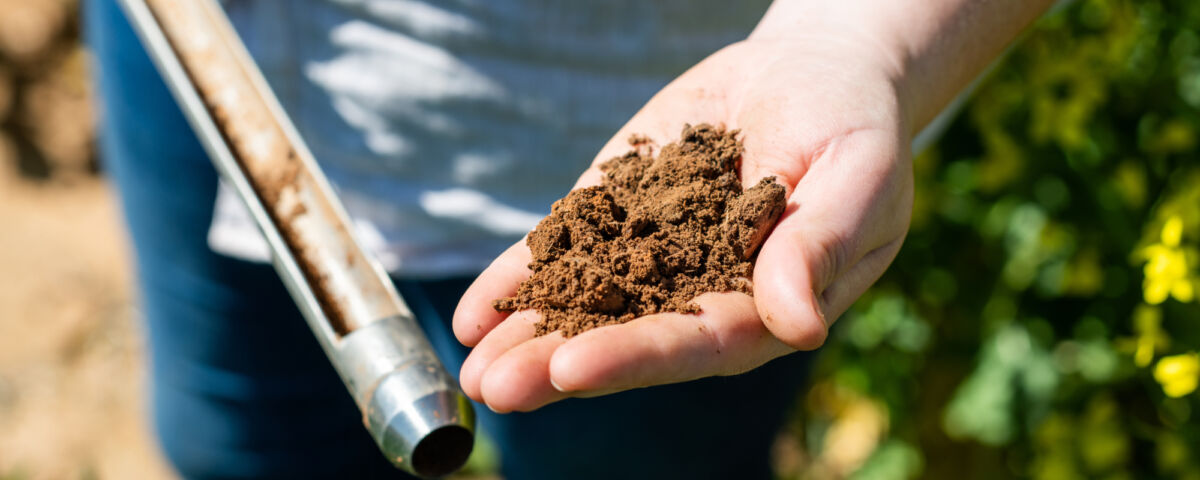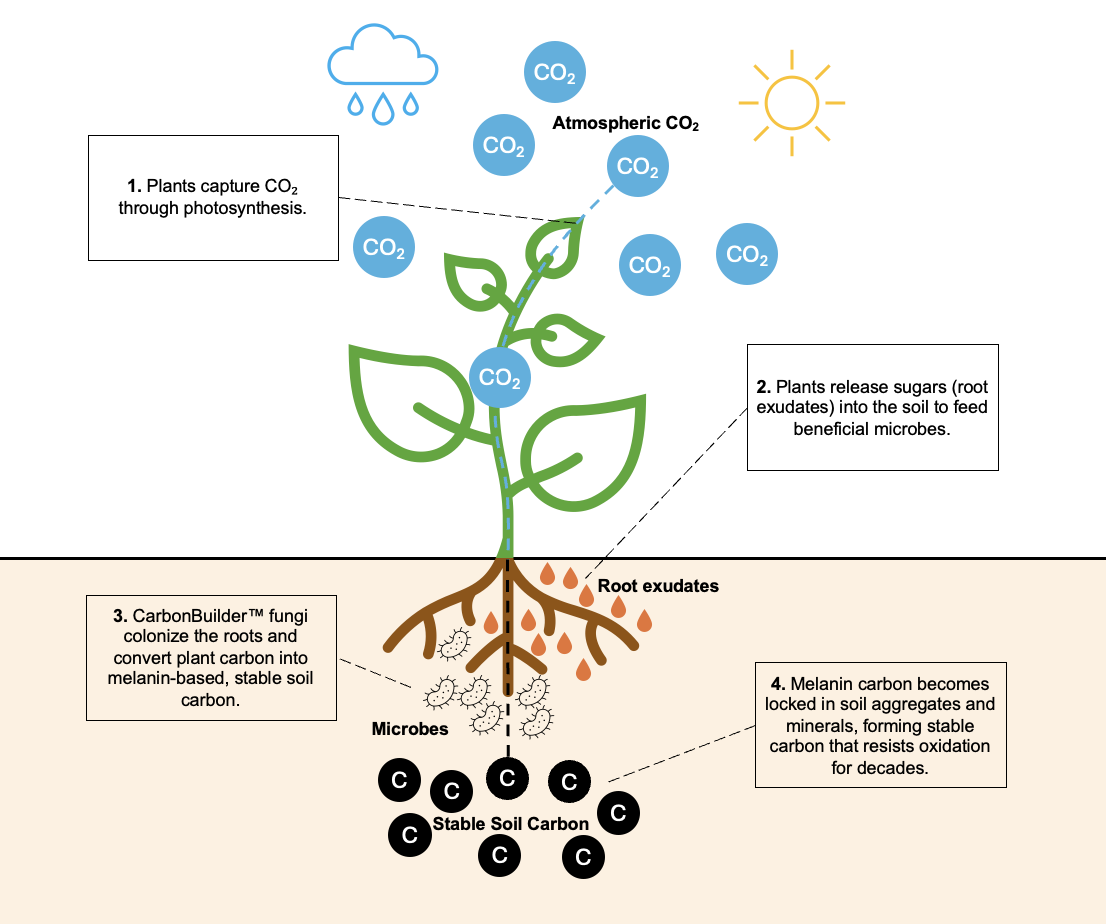





Keep this story going! Share below!
Loam Bio’s main innovation, CarbonBuilder™, is a microbial seed inoculant that strengthens the natural ability of crops to store carbon in the soil. The technology uses selected endophytic fungi that live symbiotically with plant roots, converting plant-derived carbon into stable forms that remain in the soil for long periods. Unlike many carbon-farming methods that require major changes to farm management, CarbonBuilder™ is applied as a simple seed coating and fits easily into existing cropping systems. Given the scale of global farmland, this approach has the potential to remove gigatons of CO₂ from the atmosphere if adopted widely. By improving soil health, enhancing resilience, and supporting long-term carbon sequestration, CarbonBuilder™ directly contributes to global sustainability goals (SDGs 2, 8, 9, 12, 13, 15).
CarbonBuilder™ is a microbial seed inoculant comprising selected dark septate endophytic fungi which establish a symbiotic relationship with plant roots. When applied as a simple seed coating, the microbes colonise the rhizosphere and use root exudates to produce melanin, which is a stable, aromatic form of carbon that binds tightly to soil minerals and microaggregates. This process transfers atmospheric carbon, captured through photosynthesis, into long-term soil storage, where it can remain for centuries. Unlike conventional soil carbon methods, which require changes in land management, CarbonBuilder™ can be integrated seamlessly into existing cropping systems.
The technology originated from soil microbiology research in Australia, where Loam Bio identified fungi that thrive in harsh, nutrient-poor environments. These strains were then isolated, optimised and matched to major crops such as wheat, corn, soybeans and barley, creating a scalable product suited to broad-acre farming. Field trials in Australia, the United States and Brazil have demonstrated measurable increases in soil organic carbon alongside improved crop yields, showing that carbon sequestration and productivity can go hand in hand.
To ensure scalability, Loam has developed SecondCrop™, a platform that enables farmers to measure, verify and monetise their soil carbon gains. It manages registration and certification, converting the carbon stored through CarbonBuilder™ into verified credits. “You’re growing your grain crop as normal on top,” Webb explains, “and now you have another crop underground, called a carbon crop.” Together, these innovations support the UN Sustainable Development Goals by providing farmers with a practical and economically viable way to improve soil health (SDGs 2 & 15), strengthen their livelihoods (SDGs 8, 9 & 12), and contribute to climate action (SDG 13).

Process of CO₂ conversion into stable soil carbon by CarbonBuilder™. Source: own illustration.
In our interview with co-founder Guy Webb, he revealed that he grew up on a family farm, where he witnessed how industrial practices degraded landscapes. “We were decarbonizing the landscape, because there was a financial signal to do that,” he recalled. Disturbed by these impacts, he studied environmental science, focusing on soils, to explore ways of combining food production with ecological outcomes. Educating himself on climate change, he realized: “Once you pull the curtain back, you can’t unsee it. This is a real existential threat to civilization.” He also saw that the world’s most significant terrestrial carbon sink —representing 1.8 billion hectares of global cropland —could be realised if managed differently.
The breakthrough came at a conference when Professor McGee presented research on fungi that could dramatically increase stable soil carbon. Webb described it as “a hallelujah moment, the clouds parted and the angels started to sing.” Unlike complex practices, this technology required only a single, simple intervention: add a fungus to the seed.
Loam Bio was founded in 2019 by four co-founders: scientist Guy Webb, farmer Tegan Nock, farmer Mick Wettenhall, and entrepreneur Guy Hudson. Nock reflected that when this work began, “it was something that once it bites, it’s so hard to step away from. I wanted to make sure [the innovation] was available to all farmers” (Financial Times, 2023). The collective sense of urgency and climate change concerns among the founding team created the foundation for Loam Bio’s mission, which remains driven by both scientific innovation and farming realities.
Environmental impact
Loam Bio’s CarbonBuilder™ enables plants to capture atmospheric CO₂ and store it as stable carbon in the soil. Field trials have demonstrated that an additional 3-6 tonnes of CO₂ are sequestered per hectare per year, and treated plots showed 9.4% more total soil carbon at harvest (Loam Bio, 2025). Recent scientific studies found that select non-mycorrhizal fungal isolates, similar to Loam’s, significantly increased soil carbon stability and storage (Stuart et al., 2024). Loam’s method can lock in more than twice as much carbon as conventional regenerative agriculture while also improving soil water retention and nutrient storage (New York Times, 2023). These results advance SDG 13, SDG 15, and SDG 12 by reducing emissions, restoring ecosystems, and promoting sustainable farming.
Social impact
By rebuilding soil carbon, Loam improves resilience against climate stresses such as drought, heat, and floods. This fosters “more resilient food systems,” and farmers benefit from soils that sustain yields under harsher conditions. These outcomes advance SDG 2 and SDG 8 by creating new opportunities for rural livelihoods.
Economic impact
SecondCrop™ creates a new revenue stream by monetising stored carbon. As Webb emphasizes, “if you dial up the economic outcome for the farmer, you dial up adoption.” Long-term farmer contracts emphasize the trust in Loam’s model (New York Times, 2023). This dual benefit of income diversification and climate action makes Loam’s innovation scalable. By that, Loam contributes to SDG 8 by supporting economic growth and to SDG 9 by fostering the development of carbon credit infrastructure.
From the start, Loam recognised that deploying its innovation at scale required a commercial pathway. As Guy Webb reflected, “There isn’t enough philanthropy to get you to deploy at scale; you need a financial business model for deployment.” The company received significant support after proving significant carbon sequestration, including AUD 105 million in Series B funding from the Clean Energy Finance Corporation (CEFC) and international climate-focused investors. Overall, Loam has reportedly raised more than $150 million in capital (Financial Times, 2023). These investments enabled the company to commercialise CarbonBuilder™ in Australia, expand into the United States, and enter the Brazilian market.
Revenue now flows from two channels. CarbonBuilder™ inoculants are sold as seed lubricants, requiring no change in farming practices, which makes them easy and low-risk to adopt. Through its SecondCrop™ service, Loam manages the registration, sampling, and verification of soil carbon projects in accordance with recognised frameworks, such as the Australian Carbon Credit Units (ACCUs) programme. Each tonne of verified carbon stored in the soil generates one tradable credit, which can be sold to the government or private buyers looking to offset emissions. By handling the technical and administrative requirements, Loam lowers the barriers to entry for farmers and increases long-term participation.
This dual model diversifies Loam’s income, aligns their interests with those of farmers, and strengthens investor confidence. It places the company as a leading innovator in agricultural technology and a facilitator of carbon projects, positioning it at the intersection of regenerative farming and climate solutions.
The company has unlocked a climate action tool that is both farmer-friendly and scientifically sound by using microbes as "nature's carbon traders" (New York Times, 2024). Farmers who use CarbonBuilder™ don’t have to change their methods. This approach leads to immediate productivity gains while enabling cropland to function as a long-term carbon sink.
This technology advances SDG 13 (Climate Action) through the sequestration of atmospheric CO₂. Loam's expansion to 100,000 acres, which is expected to double to 250,000 acres in 2025, demonstrates the fast scaling of this innovation (New York Times, 2024). Compared to conventional regenerative methods, the CarbonBuilder™ significantly enhances soil fertility, improves water retention, and more than doubles carbon storage capabilities (Financial Times, 2023). Through ecosystem restoration and biodiversity enhancement, these soil benefits contribute to improved food security with SDGs 2 (Zero Hunger) and to SDG 15 (Life on Land).
Additionally, SecondCrop™ generates a new source of revenue for rural farmers, which aligns SDGs 8 (Decent Work and Economic Growth). Through the improvement of nutrient cycling and the minimization of the use of artificial fertilizers and pesticides, Loam also aligns with SDG 12 (Responsible Consumption and Production) (Financial Times, 2023). By fostering carbon credit infrastructure, Loam is helping to advance SDG 9 (Industry, Innovation and Infrastructure).
References
Financial Times. (2023, July 2). Microbes on the farm: A solution for climate change? Financial Times. https://www.ft.com/content/71422ca3-6cc8-46c3-9f59-768a501b85f3
Guy Webb Interview (25.09.2025), Agronomist and Co-founder, Loam Bio.
Loam Bio Australia. (2025). Loam Bio Australia [Website]. https://www.loambio.com
Stuart, E. K., Castañeda-Gómez, L., Buss, W., Powell, J. R., & Carrillo, Y. (2024). Non-mycorrhizal root-associated fungi increase soil C stocks and stability via diverse mechanisms. Biogeosciences, 21, 1037–1059.
The New York Times. (2024, August 10). Can dirt clean climate? Australia bets microbes can turn soil into a carbon sink. The New York Times. https://www.nytimes.com/2024/08/10/climate/climate-change-fungus-carbon-australia.html
Get stories of positive business innovations from around the world delivered right to your inbox.

Founded in 2019, Loam Bio is an agricultural biotechnology company headquartered in Orange, New South Wales, Australia. The company develops microbial solutions that enhance soil health, increase soil organic carbon, and improve farm productivity. Loam’s work bridges science and agriculture by empowering farmers to build resilient, climate-positive cropping systems. Through collaborations with leading research institutions, such as Western Sydney University and Lawrence Livermore National Laboratory, and with growing international investment, Loam has positioned itself as a pioneer in the emerging carbon farming economy.